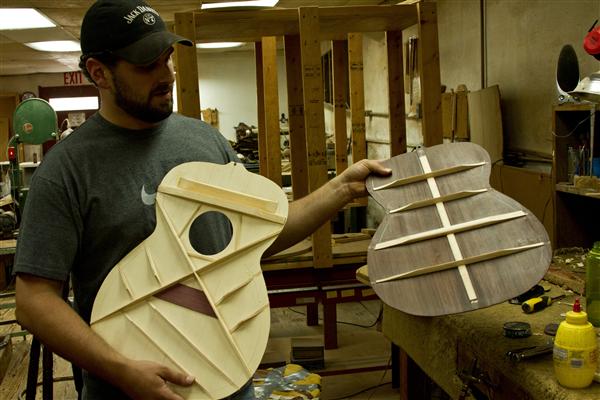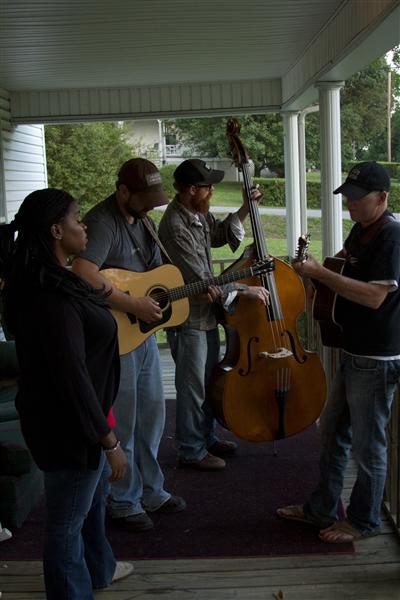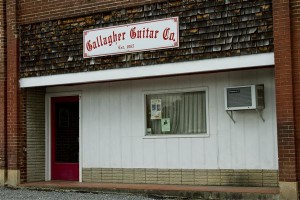Now that the air has warmed to the consistent 100+ degree days, it’s the perfect time to step outside into the yard with pant cuffs rolled up five or six inches above bare feet and just listen carefully to what’s going on around here. These are the months where the sounds of Tennessee’s lawn orchestras echo through the air, but instead of the strings, woodwinds, brass and percussion sections one might think of when hearing the word orchestra, it’s the more homely sound of the just-as-disciplined traditional-style banjos, fiddles, mandolins, harmonicas and flat-picked guitars echoing harmony from our shaded porches beneath our leafy trees. It’s the sound that makes anyone feel right at home whenever or wherever heard and even in the bitter face of playing in record-setting heat, as well as in the face of recently losing a couple of giants of the genre, new and veteran traditional and bluegrass instrumentalists are making sure that foot-tapping and good times prevail by bringing together communities across the state to play, sing and listen together.
And while together, people are celebrating and discussing how this musical heritage and the people who keep it alive continue to spread love from the biggest stringed band you can find on stage in front of a huge crowd all the way down to a sole picker singing on a small-town porch, just he and a stringed instrument of choice he’s made himself.
Oh, yes! It’s time for the 35th annual Uncle Dave Macon Days July 13–15 this year, where competitions are held for old-time bands, solo stringed instrumentalists and harmonica players (and buckdancers, too!) who gather from all over in that cozy little corner of Murfreesboro proper for a weekend of sharing laughs, good food and the chops they’ve all acquired over the past year. This is probably the most anticipated summer event for this town outside of school letting out for the kids and never fails to be a smash hit for visitors and locals, musicians and businesses, alike.
Though Macon Days is the biggest traditional-style music festival in Middle Tennessee, it’s just one of the places in the area that belt out our sweet musical heritage into the hot days turned cool nights’ skies.
On a smaller scale, there was recently the two-day annual Wartrace Musicfest the first Friday and Saturday of June located about half an hour’s drive south of Murfreesboro in Wartrace, where you could literally hear bluegrass echoing across the hilltops from miles around. This particular festival consisted of even roots-ier bluegrass and blues musicians with hearts and spirit just as big as the entirety of Macon Days, all picking and grinning through the smells of barbeque and cheers. With acts such as The Orphan Brigade and The Bad Moon Blues Band, the Wartrace Musicfest also stands as a great representation of where traditional Southern music was born and where it genuinely exists.
However, on an even smaller scale location-wise, where the music exists but more so where it is genuinely born, is a tiny guitar shop in Wartrace next to the train tracks running through their main street a few miles from the field that the Musicfest was held in.
Gallagher Guitar Company was founded in 1965 after furniture maker JW Gallagher and an old Air Force buddy were hired onto the Shelby Guitar division of Slingerland Drum Company’s Solar Music plant in Shelbyville to craft cheap plywood guitars to market to students.
“That was in ’63 and ’64,” said Stephen Gallagher, third-generation guitar craftsman at Gallagher Guitar Company. “Then in ’65, he decided to build his own out of solid wood, what he called a furniture-grade guitar because he wanted the best quality. He called it a G-50, because he was 50 years old when he started the company.”
Now, almost 50 years later, Gallagher Guitar Co. still upholds the same “furniture-grade” guitar-making process pioneered by JW Gallagher and, in that time, have established a pristine reputation sworn by collectors and musicians, alike, as their hand-made guitars are carried around the world by the likes of players Barry Waldrep, Zac Brown, and most of all, Doc Watson, who was arguably the world’s greatest flat-picker whom the traditional community painstakingly lost at the end of May this year.
“This was his first Gallagher guitar,” Stephen Gallagher said holding up a mahogany-based six string with an embossed leather strap in his family’s Wartrace shop. “It’s a 1968 G-50. And this was the strap left on it when he gave it back to us.”
.jpg)
Doc Watson, 1923 - 2012
“It was technically loaned to him by my grandfather,” he continued. “In 1968, when they met Doc at Union Groves Fiddler’s Convention, Doc and Merle invited them back to their house—it was Easter Sunday—to hang out and so they could check out the Gallaghers [guitars]. So my grandfather and dad go to their house, and they had this [mahogany] guitar and a rosewood, which is the one they thought he would take because that was the nicer guitar, but [Watson] really, really loved [the mahogany] guitar. But the problem was, this crack right here on the bottom. When my grandfather had built the body, it had cracked but they didn’t have any other mahoganies to take to the show. My grandfather didn’t want to sell him that guitar because of the crack and didn’t want any defective guitars out there, but Doc really wanted it and said ‘I can’t see the crack anyway,’ [laughs]. So, Grandfather said, ‘You can use it as long as you want but if you ever stop playing it, I’d like to have it back.’ Well, in ’74, we built the first Doc Watson model and sent it to him. He sent [the mahogany] back to us a couple of months later and held to his word, and from ’75 to 2008, it was in the Country Music Hall of Fame. We got it back in 2008 just because we wanted to have it in our possession. We kind of baby it . . . and it’s kind of priceless to us. Because of that guitar, we’re still here today in so many ways.”
So, how does a small guitar building business in rural Tennessee get the attention of one of the best American guitar players ever to walk these lands? Stephen Gallagher was right in his story. It’s not through the looks of the instrument, but through the sound of their thoughtfully engineered, made-from-scratch six-strings.
“We use a lot of different [wood] really, but most of our standard models are made out of two different kinds: African mahogany and East Indian Rosewood, and a majority of our standard models are made with Sitka Spruce tops. It comes from the West Coast/Oregon area. All the necks are made out of a mahogany, but on our custom guitars, we’ll use Madagascar rosewood, Padua, maple, Koa, walnut. Just about anything you can think of really,” Gallagher explained standing in the middle of the raw-wood storage room before walking into the workshop itself where it’s obvious each stage of birthing a guitar is as intricate and delicately handled as the music that is meant to be played on their finished product. The room smells like every which way of fresh lumber and appears to be littered with dust, heavy machinery and wood-working tools, but the Gallaghers know everything is in its right place as they’ve built it up over the years perfect for the fluid manufacturing of their hand-crafted guitar.
Stephen Gallagher explained that the first step of building a custom Gallagher is bookmatching, or matching two pieces of wood together side-by-side so they mirror one another, giving the impression of an open book—the front and back of the guitar (usually made of Adirondack wood). This is done by an enormous wooden bookmatching machine in the corner of the shop that resembles the fan of a car engine.
While the front and back settle together, the second step is to soak two pieces of wood that will become the sides of the guitar in a boiling vat of water, for pliability, then taken to a bending press crafted by JW Gallagher, himself, when the shop first opened, where they are pressed down into the shape of a women’s buttock, then connected together in a vice-mold by little pegged wooden strips glued around the inside edges of the soon to be guitar box.
Besides the signature sound that comes out of the finished product, this is the stage in the process that gives every Gallagher guitar its true identity: the serial number.
“Every guitar gets the model number,” Gallagher said as he pointed to a little wooden block on the bottom of the sides that reads “CUSTOM GA [Grand Auditorium is the type of guitar he’s making] 3638.”
Photos by Jonathan Wesenberg
“See, this says ‘Custom GA’, and the serial number says ‘thirty six thirty eight.’ That means [what kind of guitar it is and] that’s how many guitars we’ve actually built. That averages out about 75 guitars a year. Gibson does about 70 units in a day [he laughs a hearty laugh].” Other landmark guitars laying around the shop include #250 his grandfather, JW, used to play, which is a 75 Special made out of quarter sawn Brazilian rosewood with golden tuning pegs and sound that could melt a block of lead. Also laying around is #3000, which is significant to Stephen being the first guitar he had a hand in engineering and building himself when he went into the family business.
But after the serial number is bestowed and the sides are set aside to dry, it’s time to brace the front and back of the guitar once the bookmatching has finished. Gallagher uses a very durable bracing concept called x-bracing made famous by Martin acoustics, because of the amount of tension the strings have on the guitars and the way it vibrates the front, as most Gallaghers are used for some tight, fast-paced pickings.
“It’s kind of like an egg shell, when you hold it from end to end and can’t break it. The guitar is built on the same principle,” he said. “The strings actually have about 140 pounds of tension and this is the bridge plate [he taps right below the hole on a two-finger sized piece of blue-ish wood], so your strings actually come through and the balls will pull up against this. This is a piece of purpleheart and it’s a really, really tough wood, but the ball-end will come up against it this so when you pluck the string, it vibrates the bridge plate which sends the vibrations through the top [creating] the sound while your back and sides reflect it back out the sound hole. The optimal listening point for a guitar is 6 feet in front of you. That’s where the guitar sounds its best acoustically.”
Once the body’s innards are in their right places, it’s time to glue all sides to one another and store the neckless box in a separate room from the shop that acts as a humidor while the neck is cut and sanded down from an arm’s length block of wood. The before and after shots of the raw neck to the finished neck is like comparing the graphics of an original Nintendo to a PlayStation 3’s graphics. One neck usually takes four to five hours from the before shot to get to the after shot, and that’s applying fingerboards, head plates, and all.
“We make the dovetail [joint, at the bottom of the neck] and fit it to the top [of the guitar box]. A lot of newer guitars will actually bolt on to the neck, which has its advantages, I guess, but a traditionalist likes the fact that a dovetail has a solid joint and, technically speaking, it resonates the guitar better,” said Gallagher.
Then the guitar is whole and ready for the fancy stuff done, if need be. In the back room of their small headquarters, there’s a work bench set out for pearl inlay work if a customer requests it, and they can do anything from Celtic knots, if you play Irish music, to names down the fret board if you’re into yourself, to even pictures of your dog, which they’ve done before. It’s work for a steady and patient hand, but after all that, it’s time for the finishing touch: finishing the guitar in the backest back room they have. It’s a small paint blotched nook with guitars hanging around piles of paint cans. The pungent lacquer and paint fumes smell could knock a man over if he’s not prepared and a high will catch anyone leaving the door open too long.
“I remember being a kid and my dad not wearing a mask, and that’s probably why he’s crazy, now [Stephen gives a good hearty laugh again].”
Once the finish is dried and cured using an ultraviolet light that quickly hardens a catalyst within the paint, the guitar is brought out in all of its glory, gazed upon with a sense of accomplishment, and handed off to the new proud owner of a custom, hand-made from scratch Gallagher Guitar from Wartrace, Tenn.
Stephen Gallagher picked up his own guitar beside the door when leaving the shop that day and headed to the Wartrace Musicfest to headline the first night with his quartet, The Gallagher Trio (they picked up Jake Winebrenner, the bassist from Rhythm Kitchen and Flea Market Hustlers, that night, on top of guitarist Daryl Rogers and lead vocalist MJ De Cloet) for night of blues and bluegrass that surely echoed across the hilltops of the small town.
Information on next year’s Wartrace Musicfest can be found at wartracemusicfest.org. Until then, though, The Gallagher Trio has a scheduled performance at 3 Brother’s Deli here in Murfreesboro July 21, while Stephen Gallagher’s other project, an old-time band called Sweet Fancy Mosses, will play 3 Brothers July 28, according to Gallagher, who also said he’d be making an appearance at Uncle Dave Macon Days, this year.
View more photos of Gallagher Guitars here
Gallagher Guitar Company can be reached at (931) 389-6455, or on the web at gallagherguitar.com for your own custom guitar questions and pricing information. Pictures and video of available guitars and a detailed history of the family business are available online, and they just started making ukuleles and electric guitars too!
















